Ants are among the most common pests on the planet, so there are literally hundreds of products advertised for ant control. Luckily, because they’re so common, I have a ton of experience with them and have tested many products, so I know which ones work and which don’t.
In the rest of this guide, I’m going to share with you what I have learned over the years, how to control ants effectively, and a whole lot more. We will discuss how to detect infestations, the types of ant control products, what I think are the best ant killers and some very effective prevention tips.
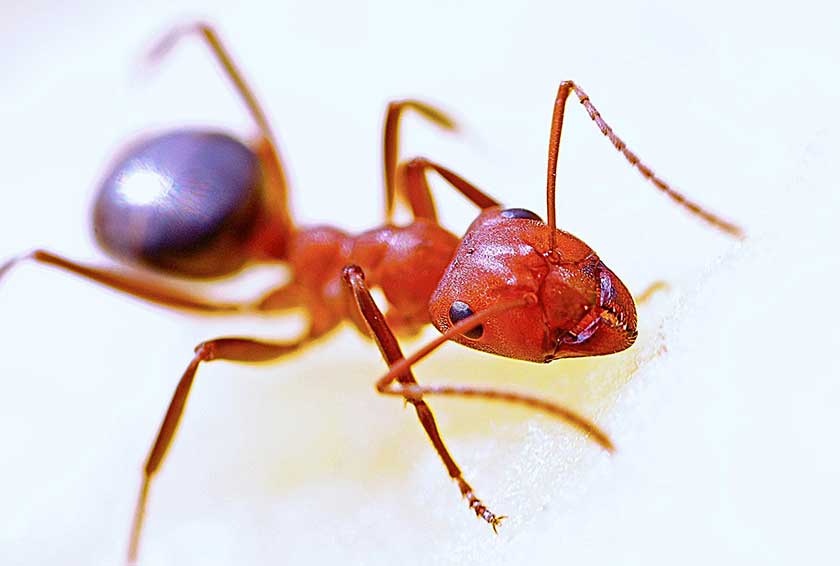
Here are my favorite ant killers for a clean, pest-free home. We will be discussing the various broad categories of ant killers, followed by a series of available products for your convenience. Each listed product will feature a miniature review to help you decide whether it’s right for you.
Be forewarned that many of these products contain insecticides or other hazardous chemicals. While not always lethal to people, these products are definitely not friendly to your eyes, skin, or any part of the body they might end up touching. In smaller doses, exposure to ant killers might cause unpleasant symptoms like nausea, diarrhea, etc.
If a small child were to consume enough of these chemicals, the results could even be fatal. Readers with children or pets should always take care to use these products responsibly, and to both store and apply them where vulnerable, curious little ones might access them.
Use this list as a jumping-off point for your pest control operation. Take a look at the best ant killer products to get an idea of what’s out there and what might work for you.
Here Are the Best Ant Killer Products
1. Terro T300 Liquid Ant Baits (Gel Bait)
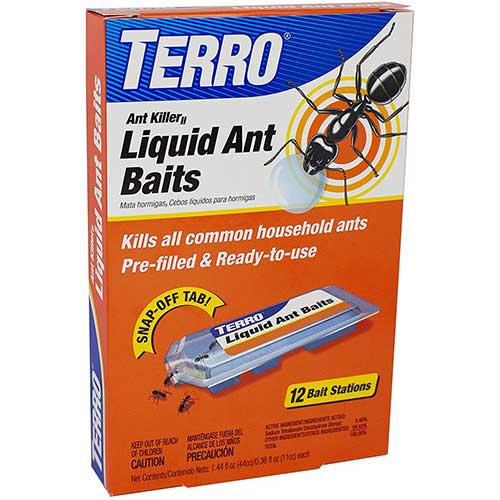
Terro ant killer luquid ant bait gel is one of the most popular products on the market. As a liquid poison, it capitalizes on the digestion process of the ant, which is limited to liquids only. Ants normally suck the juices from various morsels, so Terro makes it easy by offering poison in liquid form. This gel comes in little bait stations for those who prefer to avoid getting poisons on their home surfaces. As with most gels and liquids, the ant will take those goodies back to the colony and poison plenty of others before the slow-acting substance claims him.
This is an ant killer product for larger infestations, chain-killing by way of its irresistible allure to ant populations. Even after the early rounds of fatalities, it’s not like the little guys put two and two together — they’ll keep coming back for more. This ant killer brand markets the T300 as a universal ant killer, capable of putting down all species of ants.
We haven’t tried it on every ant species, but we wouldn’t be surprised if that were largely true. This stuff has the potential to work very quickly, but on a related note, it can rapidly dry up if not quickly consumed. Terro’s liquid ant killer is an excellent solution for active infestations, especially those that frequent certain sections of the house.
2. COMBAT Max Ant Killing Gel Bait
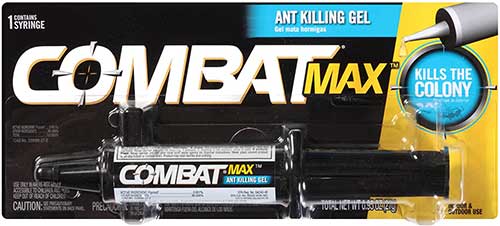
Combat Maz is anther ant killler gel. Here is a product makes its intentions known right off the bat, COMBAT intends to put up a fight, and the ants will likely lose. This is a popular ant killer gel for colony targeting. Lay down the gel, let the ants indulge themselves, and wave goodbye as they carry your poison off to the rest of the nest. This stuff isn’t provided in a housing cartridge like the T300 above, so you’ll just be dolloping it directly onto surfaces.
The container is child-resistant, but we wouldn’t take any chances of leaving it around for kids to access. Especially kids with unusually coordinated, muscular hands. This gel boasts a high water content for rapidly engaged feeding, although if there is a difference between this and the T300, we’re not certain we have detected it. The syringe is handy for reaching difficult spots, crevices, cracks, etc.
COMBAT promises “fast control of ants within 3 to 5 days,” but without the cartridges, you are looking at maybe a week of having this goop in your home. Of course, it seems like it lasts longer than the T300, so a bit of a trade-off. Another solid large-scale infestation ant killer though.
3. Raid Ant & Roach Killer (Spray)
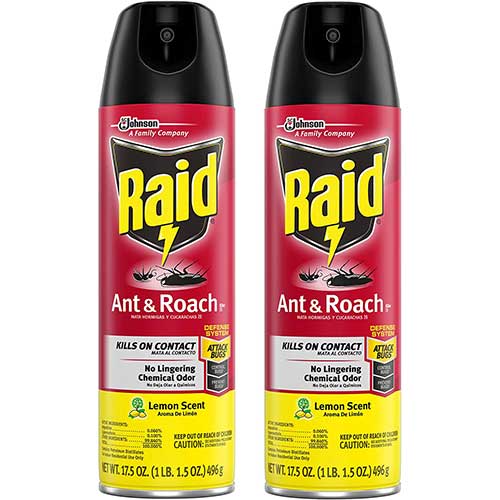
Raid Ant and Roach is a classic ant killer spray from a name everyone recognizes. Sometimes the tried and true products are still the best way to go. Raid’s spray will perform in line with traditional ant killer sprays, which is to say that it will kill on contact. This makes it a powerful “right-now” solution to smaller-scale ant problems, like when they are scuttling across the bathroom floor in a cute little line. Get trigger-happy with Raid’s old standby and literally wipe the floor with ant invaders.
This spray doesn’t create the normal chemical odor you might associate with ant killer sprays, attesting that there is no lingering chemical odor. There is some odor, to be upfront, and its dissipation depends on how many windows you have open. But it’s definitely an improvement over other ant killer sprays. In fact, it features a “lemon scent!”
Fair enough, but don’t try using this stuff as an air freshener.
4. Orange Guard Home Pest Control (Natural Spray)
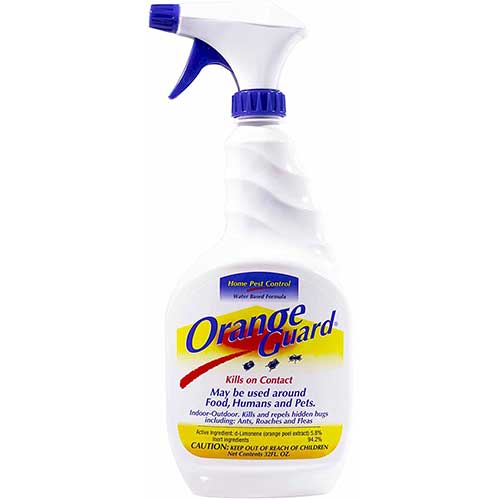
Orange guard is an all-natural insect killer. This pest control formula is registered with the United States Environmental Protection Agency an can be used indoors and outdoors. It’s derived from orange peel extract and kills ants, roaches, and fleas!
No toxic chemicals (to humans) are included in their spray formula. It is advertised as being useable around food, pets, and children. This isn’t the type of thing we’re inclined to test, but it definitely can’t be worse than your average toxic ant killer spray.
On the other hand, ants may sometimes return to places that have been sprayed with Orange Guard, meaning that the formula probably degrades over time. This is not usually something you worry about with chemical sprays like the Raid product above.
It also reportedly leaves an oily residue on painted surfaces, which is certainly not ideal. And the bottle also has some issues, it’s rather poorly constructed and may need to be transferred to a different bottle. However, for an ant killer spray that doesn’t contain poisonous fumes harmful to humans, this seems like a small price to pay. Hey, it kills the buggies on contact. Not bad.
5. Diatomaceous Earth Ant Killer Powder
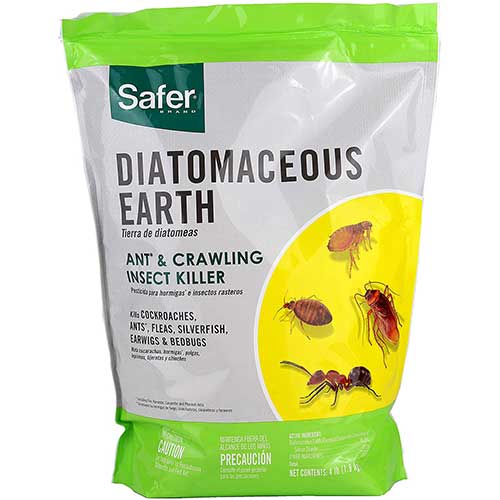
Diatomaceous Earth is a powder that kills ants and many other types of insects. This is an unusual ant killer powder, consisting not of the typical boric acid formula, but an “earth-based powder.” It still functions in much the same way as a typical powder, coating bugs and shaking off onto the other ones to pull the old chain-kill trick. As a reminder, chain killing is when one bug becomes exposed to a hazardous substance and proceeds to share it with others. They’re doing the work for you!
Instead of disrupting the nervous system, this powder kills through dehydration. The earth is comprised of “crushed fossilized freshwater algae.” It is soft to the touch of a human, but at the microscopic level, its particles have blade-like edges, lacerating ants and making them leak to death. Wow. It also absorbs the moisture in their bodies when ingested, stealing what fluids they have.
If you go with diatomaceous earth powder, one plus is that it does not contain poisonous chemicals, meaning that ants can’t develop chemical resistances to it. It is difficult to imagine an infestation surviving chemical poisons long enough to come by a resistance, but in case you are concerned for the long term, here is your powder option. But it is also EPA-approved, making it a potential pair with Orange Guard spray.
Related Article: Best Bed Bug Killers
6. Terro T600 Ant Dust Powder
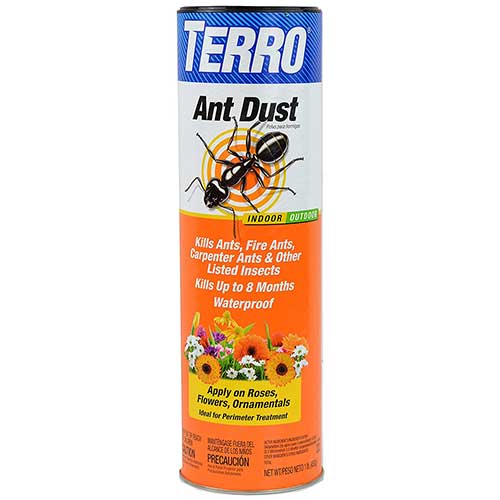
This Terro T600 Ant Dust can be used to kill ants, fire ants, and carpender ants. These names make ant killer products sound like robots from the future. The T-800 is when Arnold Schwarzenegger shows up at your house to exterminate an ant colony. As for Terro’s T600 ant killer powder, this is a more traditional choice than our previous entry. It works through poison rather than sharp earth particles. If diatomaceous earth isn’t up your alley, you can be virtually guaranteed that Terro will get the job done.
One major asset of Terro’s powder is that it’s actually waterproof. If you need to use it outside, or if it gets wet in the house for any reason, you don’t have to repowder. Pretty convenient. That being said, a downside (depending on how you look at it) is that this stuff kills ants on contact. Why is that a bad thing? Well, if they die right away, they can’t spread the powder to the rest of the colony. That makes this a powder product better suited to small-scale infestations.
7. Zap-a-Roach Roach and Ant Killer
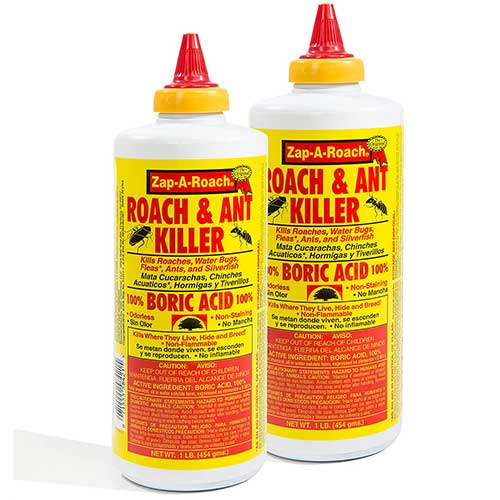
Zap-A-Roach is 100 percent boric acid that is a popular roach and ant killer. This ant killer formula is a true boric acid powder. We’re talking nervous system disruption, slow deaths, and lots of sharing amongst other ants. It’ll do for roaches or ants, as the title implies. Odorless, versatile, non-invasive, and profoundly lethal to ants, this is a classic formula from good old 1946. If it’s been killing bugs for that long, there’s bound to be something to it!
It is sometimes reported that the powder has a clumping issue, preventing truly effective ant elimination. It needs to be lightly dusted over surfaces for maximum impact. Extreme temperatures or moisture might cause a clumping effect, so be careful where you store it. Store in locations of moderate temperatures where possible.
8. Max Catch Ant Glue Trap
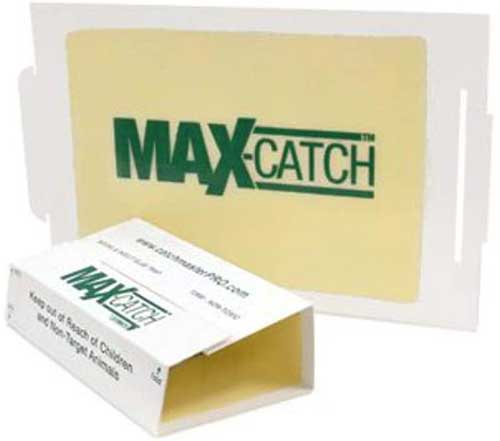
These Max-Catch glue traps are so sticky they can even trap small rodents! That being the case, a few little ants will be no problem. Any place chemicals are not permitted, your best bet may be a glue trap. Placement is key with Catchmaster traps, as you need the ants to actually walk into them. A little food, peanut butter, fruit, etc., can go a long way as enticing bait.
This is a child and pet-friendly option. You can simply use a bit of vegetable oil to grease up a sticky little one’s hand when caught in the glue. Glue traps are generally not the main event in ant killer products, but if you are limited in your options, Catchmaster is among the best.
Related Article: 14 Best Ways to Get Rid of Mice
Types of Ant Killers (What You Need to Know)
Here we’ll overview common ant killer products by type. This way, when you view our favorite ant killer products below, you will know what you’re working with. Sometimes, an ant killer product will not actually include a description of its basic functionality! We can help with that.
Ant Spray
Sprays are among the more popular ant killers available. They are one of the simplest, easiest methods of ant control, useable at a moment’s notice to take care of immediate ant issues — for example, as they are crawling across your kitchen floor. This is no time to fuss with powders and gels! Just pick up your ant killer spray, give those little guys a spritz, and sweep up the remains.
Ant killer spray can also be used preventatively. Spray it on surfaces of your home where you expect ants might like to travel and live. It can ward them off entirely; ants detect the toxic odors and typically avoid them. Be cautious when using sprays this way, because a surface you have coated with insecticide is not one you would like to touch anytime soon.
Sprays can come in the form of liquids or foams. The benefit of a foam spray is that it expands into difficult crevices. Where a liquid would merely pool or drip, a foam will become this sort of enlarged, lethal bubble bath. Not that insects would generally like to bathe in it. In fact, they much prefer to avoid this stuff. That’s why sprays can be used predictively.
If you are using ant killer sprays predictively, be sure it is on surfaces such as those beneath refrigerators, below the sink, behind your toilet, etc. Ant sprays alone may solve smaller infestation problems, but a large infestation is likely going to require the really big guns (baits and traps). Still, some handy ant killer spray is no friend to an infestation, and we recommend having one on hand. (They are rather satisfying to use) Where is your queen now, home invaders? Take that!
Liquid or Gel Bait Ant Killer
Trust us on this one — liquid/gel bait is worth its weight in dead ants. Make no mistake, liquid bait works. Where sprays are like the handguns of ant killer formulas, liquids and gels are more like the nuclear missile. It’s DEFCON 1, readers, and once you begin placing liquid/gel baits around the house, the Cold War has gone red hot. Hit those ants where it hurts with alluring gel, enticing them to visit your buffet of liquid death.
One of the best features of gel and liquid baits is that ants are communal insects. They won’t wrangle that gel all by their lonesome. They will call on their comrades, and streams of them end up lathering themselves in this tasty goop. Then they return to the nest and share their findings. This is sometimes known as “chain-killing”: Poisoning one insect, who proceeds to take down many more with him. If you’re lucky, they will share with the queen herself, which is just about the fastest way to take down an ant nest. Sharing is caring!
Ant Poison In the Liquid or Gel
The poison is necessarily slow-acting, which brings us to a potential con: The ants who partake of your poison bait will not die immediately. With bait, you are in for the long game. It takes time for the gel to reach and disrupt an ant’s nervous system, which is important because that time is spent exposing other ants to the bait. What you may at first find, if the bait is working, is that ants will seem more numerous than usual as they feast on your bait.
We know you didn’t want more ants. But after a brief, localized peak of ant activity around the bait, that ant presence will steeply decline, and you will know why.
These poisons are sometimes sold alongside traps, or small cartridges in which the poison sits. The ants go marching into the trap, then out they go to spread the gel amongst the colony. The trap is a convenient little package with the poison already inside.
Thus, you don’t have to be dropping or spreading ant poison directly on surfaces throughout your house. This makes for a cleaner solution, although it does somewhat limit the application. Sometimes, a drop of gel is easier to place in small crevices than a trap. It certainly doesn’t hurt to equip some tube-dispensed gel, and some additional gel traps to boot.
Powder Bait Ant Killer
Not unlike gels, ant powder is another chain killer that baits ants into approaching it and getting friendly. The powder coats the bodies of the ants, dusting them and invading their nervous systems. Slowly, the powder takes hold, and the ants return to their colonies, coating the others with the powder and eventually triggering mass death.
The chief ingredient in this stuff is boric acid, which while deadly to insects, is significantly less harmful to human anatomies. All the same, don’t get cozy with this stuff. Dust surfaces with a thin layer and wait patiently. This material doesn’t usually come in traps, so you’ll be applying it directly in most cases.
In the case of any bait, it can be highly effective to place electronic repellents in areas without traps. These repellents give off vibrations and sounds that are unpleasant to a variety of insects, causing them to relocate. Using these repellent devices, you can potentially herd the ants into a specific region of the home, where they will be likely to encounter your bait.
Glue Traps Ant Killer
Some people prefer to avoid chemicals altogether. Glue traps are one solution for folks looking to get rid of infestations without sprays, gels, and powders. A glue trap can be placed near areas of your home that ants frequent, providing a nasty little surprise for them upon entering. They will stick to the trap, helplessly fused and unable to do much of anything until they die. If the ants struggle too hard, their limbs can rip right off, resulting in a quicker, but more painful death.
Sometimes it’s a good idea to combine different types of ant killer products. This is not a product that works well with slow-pace chain killers like gels and powders. The reason is that glue traps actually inhibit ants from spreading slow-acting poisons amongst their colonies. You can’t share with your friends if you’re caught in a glue trap!
One other issue is that without baits of some kind to lure the ants, glue traps may be ultimately less effective than some other ant killer options. They have to walk into the trap before it can snag them.
Information About Ants
Ants live in colonies that have a complex social structure. Their surprisingly productive little societies are sustained by huge amounts of effort from all the involved ants. The populations will usually consist of:
Female ants, which come in two types:
- Queens, or reproducers whose job is to coordinate the colony and keep ‘em coming — more eggs, more problems. For you, that is. New queens leave to attempt their own colonies.
- Sterile female workers who tunnel, scavenge, feed, and generally make life possible. These ants produce the day-to-day labor required to keep an ant colony afloat.
Pupae, larvae, and eggs:
- These are your sweet little baby ants that get pumped out by the queen. They can be seen in the clutches of adult worker ants who scuttle around with the colony young when nests are disturbed.
Male ants:
- Their chief responsibilities consist of mating and getting out of the way. They die shortly after mating. There are ups and downs to this lifestyle.
Infestations and How to Detect Them
Why Do Good Homes Get Infested by Bad Ants?
The answer is basically a matter of nature: Food! Ants are hungry, and they need to provide for their queen and young to keep the colony going. What do you know? Your house is full of food! Scavenging and foraging for food are about as fun as they sound, which is to say not very.
In fact, most budding ant startups don’t even make it to the big leagues. Once a lone queen is fertilized, she can begin producing worker eggs. The first worker ants that she births are smaller and less capable than normal ants since they are the first generation and there is no one to pamper them. This early generation will care for the queen’s next round of eggs, nourishing them into stronger adults.
But this process takes time, and seasonal changes, predators, and plenty of other things can get in the way. Sometimes, it can take up to a couple of years for an ant colony to really get the ball rolling.
You can bet that due to these challenges, ants have sensitive instincts for food detection. If they catch a whiff of your food, or if your house is a more manageable temperature than the cruel outdoors, they will bring the colony to you at no extra charge.
How Do I Know if My Home is Infested by Ants?
There are a number of signs to look for as you determine whether you are looking at an infestation or just a few visitors. Of course, ants leave trails that can be detected by other ants. If there are a few now, more may be on the way. Check for the following signs as you determine whether it’s time to get serious and pick up some ant killer.
They’re Using Your Leftovers as a Buffet
If you happen to leave some food out, which we do not advise you to do in the first place, you may notice that the food is covered in ants. This is a sign of potential infestation. A couple of ants here and there is one thing. But a swarm of them can spell trouble for sure.
Mysterious Ant Shavings
Carpenter ants, a very common species of nesting insects, will often destroy wood. They won’t consume it the way that termites do, but they can certainly damage it. If your home features wood structures with mysterious gouges and nearby shavings, you could be looking at evidence of a carpenter ant infestation.
Ants Have Set Up Operations in Your Yard
If you happen to have spied a colony of ants in your yard, you may be in for an infestation. Ants often travel a long way just to pick up some food, and they can smell that your home is full of it. For that matter, they just don’t have a sense of boundaries. They will waltz right into your place, pick up your grub, and away they go. Impertinent little things, aren’t they?
They Lead You Right Home to Mama
Ants are not renowned for their discretion, and if you leave a bit of food out, they will be happy to show you exactly where their colony is nesting. One by one, they will march home in a line to show the queen what they found. This may seem devious, and that’s because it is. But if it can save you the trouble of eyeballing your whole house for signs of nests, well, it’s hard to say no to catching their six and tailing them all the way to their pad.
Avoiding Ant Infestation
With baits, traps, and various poisons at your disposal, you are armed and ready for the ant apocalypse. Even so, it is better not to find yourself in a position where killing off an infestation is your main option. Most ants are not vicious like spiders, nor are they loathsome in the way of the cockroach. They’re just trying to eke out a living and support their communities with food and shelter.
Ideally, you can just keep them out of the home to begin with, and there will be no extermination necessary. Exterminations can be long, drawn-out affairs where you seem to just fight the insects forever. Just when you think you’ve put an end to them, here they are again! In the interest of not going down that road, here are a few tips for preventing ant infestations — way easier than going man vs. bug.
Of course, if your house gets infested with mean little fire ants, we won’t blame you for enjoying the extermination process just a bit.
Keep Place Clean To Avoid Ants
Dirty homes, especially those with food lying around, are prime real estate for ants. The more clutter, the more havens they have in which to take shelter. Ant colonies that are denied food will be motivated to relocate to someplace they’ll have an easier time. If you keep dishes washed, garbage allocated to closed bins, and food stored tightly away, you are giving ants as few reasons as possible to establish themselves in your home.
It probably goes without saying that during the extermination process, this is especially important. Not only will you be actively killing off the colony, but you’ll also be depriving your home environment of its last morsel of ant hospitality. Importantly, if you do not maintain a clean environment, you will be relying heavily on traps and poisons, which can cost you time, money, and peace of mind. You don’t want to live around traps, nor the lurking pest they represent whenever you look at them.
This goes double for homes with small children, which are admittedly more difficult to keep clean (by a long shot). But these are precisely the homes in which you do not want to rely on poisons too heavily, in light of curious little ones.
Ant Barriers
Barriers can be a helpful tool to limit the mobility of searching worker ants. These can prohibit pesky ants from getting into certain areas of the house, or keep them corralled to one region. Sticky materials, like that found in glue traps, can be placed over certain borders. For instance, if ants like to crawl through your kitchen door leading to the backyard, a sticky strip can stop them in their tracks. With barriers, you can not only keep ants away from key areas of the home, but direct their passage through the house to a certain extent. For the one-two-three punch, try poison bait and a series of repellents supplemented by barriers.
Prevent the infestation of vulnerable furniture, children’s’ bedrooms, or food storage units with thoughtful placement of barriers. Alternatively, caulk can be used to seal cracks in the floor and walls that ants might use to maneuver their way through your home. This is pretty quick and painless — find the cracks and seal them up! The fewer access points ants have to your house, the tougher it is for them to forage effectively.
Ant Killer Product Conclusion
Feel free to experiment with combinations of the options listed on our top-8 list. If one doesn’t do the trick, it may be that it needs a little supplementation. Powders and gels can work quite well together, for example, since they offer two different tasty options depending on the ants’ moods.
Related Article: 7 Best Ways to Get Rid of Fire Ants
Key Points to Get Rid of Ants
- Keep a clean home to avoid inviting ants inside. They can detect food from a ways off.
- A colony in your backyard may not remain there. Ants are often compelled to enter homes, attracted by the food. Best to set a good gel or powder right next to any colonies you find outdoors near your home.
- If you notice an infestation, one simple way to locate their nest is to follow the trail. Those little workers will take you right to it.
- The main ant killer options are as follows:
- Gels: Goopy poisons that entice ants with their sweet odors. Ants pick up the gel, take it home, and share it with their comrades. Mass death. This is known sometimes as “chain killing.”
- Powders, typically made of boric acid. These are another slow chain killer poison, savaging the ants’ nervous systems as the powder floats around and clings to the colony workers.
- Sprays: Insecticides that kill on contact. You see an ant, you spray an ant. Simple as that. These can also be used to establish barriers from ants along door lines or other key areas. They are not insidious like gels and powders — a spray will ward ants away.
- Glue traps: Not the finest ant killers ever invented, but sometimes you live somewhere poisons and other solutions are not permitted. A glue trap can actually do alright with some sweet food to lure the ants into their own sticky fatalities. They’ll never make it to the bait.
That’s a wrap! Keep our guide to the best ant killers bookmarked for ease of reference, and start equipping yourself with a few options from our favorite range of pest control products. Good hunting, exterminators.
My name is Blane and I’m a life-long resident of Southeastern Louisiana. I’ve been working as Pest Control Technician and Inspector for about 1.5 years now.
I’ve worked in many other industries as well, including consulting, managing, as well as at the ground level in fields including Food Service, Corporate Automotive sales, and finance. Whether it be providing counsel, content, or hands-on support; my goal remains to add value to the lives of the people I serve.
If you have any questions regarding pest control, leave them below. I would be happy to help you out in any way I can.
